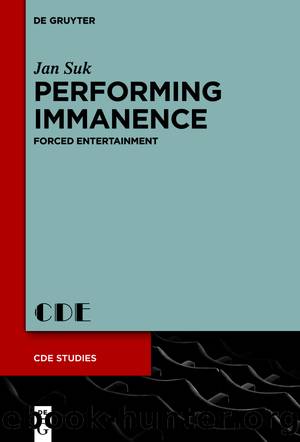Performing Immanence by Jan Suk

Author:Jan Suk
Language: eng
Format: epub
Publisher: De Gruyter
Published: 2021-03-20T21:17:25.862000+00:00
If thought searches, it is less in the manner of someone who possesses a method than that of a dog that seems to be making uncoordinated leaps. We have no reason to take pride in this image of thought, which involves much suffering without glory and indicates the degree to which thinking has become increasingly difficult: immanence (Deleuze and Guattari, Philosophy 55).
Thinking, according to Deleuze and Guattari, is an unorganized yet organic process. The leaping dog is an image that is jarring, although very rhizomatic and unexpected. The image of a leaping dog is liberating and joyous. Such a methodology is far from systematic and anchored; rather it is ephemeral and poly-rhythmical. Similarly, in the context of the immanent performativity, Brian Massumi speaks of the ultimate desire to live like a thought: â[t]hought does not reflect the real. It is real. It has a reality on a par with the worldâs becomingâ (âThoughtâ 29, original emphasis). The equation of thinking and the worldâs becoming is mutually transformative.
This immanent relationship is complementary to lived reality: âthe inclusion of conditions for new emergence in the world that determinately emerges, and reciprocally the inclusion of the determinately emerged in the field conditions for new emergenceâ (âThoughtâ 33). The relationship between the lived world and that of performance is transversally interconnected, with a similar quality to that of an unfinished literary machine. Immanence manifests its interconnection and the reciprocal relations to something, a relation that is creative. The creation âis a process in perpetual motion, less a completed burrow than a ceaseless burrowingâ (188), as Ronald Bogue observes. For Deleuze, Bogue continues, writing is a transformative process, a passage both for the writer and the reader, a mutually deterritorializing movement. To write is to flee (192), Bogue, states, to enter another dimension, more or less illusionary. Yet the illusionary, be it for writing or theatre, is etymologically not far from the Latin in lusio, from entering the game.7 Speaking about games, Laura Cull observes that for Deleuze, the game of dice âis a game with two moments: âthe dice that is thrown and the dice that falls back.â However, for Deleuze this distinction does not form the basis of a radical distinction, but an immanent differentiation, since they are âtwo moments of a single worldââ (in Cull, Immanence 51). If the logic of Deleuze is to be pursued, the bad player throws the dice again and again in order to achieve a desired combination that has already been determined in advance, Deleuze maintains.
According to Cull, âthe good player affirms whatever combination emerges as the right one, in a gesture of amor fatiâor love of fateâwhich for Deleuze constitutes an ethical valueâ (Immanence 51). Here it must be again that Deleuzian understanding of ethics is very open. Cull stresses Deleuzeâs intrinsic belief that âethics is a matter of experimenting with what we can do; going as far as possible to produce joyful affects rather than sad ones, of creating relational bodiesâ (226). This positivistic and
Download
This site does not store any files on its server. We only index and link to content provided by other sites. Please contact the content providers to delete copyright contents if any and email us, we'll remove relevant links or contents immediately.
4 3 2 1: A Novel by Paul Auster(11790)
The handmaid's tale by Margaret Atwood(7448)
Giovanni's Room by James Baldwin(6809)
Asking the Right Questions: A Guide to Critical Thinking by M. Neil Browne & Stuart M. Keeley(5356)
Big Magic: Creative Living Beyond Fear by Elizabeth Gilbert(5352)
Ego Is the Enemy by Ryan Holiday(4957)
On Writing A Memoir of the Craft by Stephen King(4663)
The Body: A Guide for Occupants by Bill Bryson(4583)
Ken Follett - World without end by Ken Follett(4443)
Bluets by Maggie Nelson(4261)
Adulting by Kelly Williams Brown(4234)
Eat That Frog! by Brian Tracy(4149)
Guilty Pleasures by Laurell K Hamilton(4116)
White Noise - A Novel by Don DeLillo(3829)
The Poetry of Pablo Neruda by Pablo Neruda(3815)
Fingerprints of the Gods by Graham Hancock(3738)
Alive: The Story of the Andes Survivors by Piers Paul Read(3730)
The Book of Joy by Dalai Lama(3697)
The Bookshop by Penelope Fitzgerald(3619)
